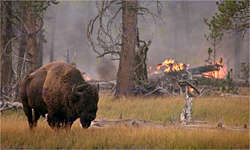 Not so long ago forest fires were seen as an extremely harmful influence on the ecosystem. People have since realized that fire is a natural and healthy part of the ecosystem, and further that suppressing forest fires can have devastating effects.
Not so long ago forest fires were seen as an extremely harmful influence on the ecosystem. People have since realized that fire is a natural and healthy part of the ecosystem, and further that suppressing forest fires can have devastating effects.
Natural forest fires are typically started by lightning strikes. Once ignited, their spread is dependent on weather conditions and the fuel available in the forest. Areas with large amounts of vegetation near the ground are more fire-prone. If these fuel sources get the fire hot enough, it can also jump into the tops of the trees and spread from there. In a healthy forest, however, this is relatively uncommon.
Once the fire has burned itself out the process of succession begins. Depending on when the next fire takes place, this may take 300 years or more. In the first stage the forest is composed of primarily herbaceous vegetation and smaller pines.
As time passes the trees get bigger while competition for light and other resources tends to thin out the forest. Fires are relatively uncommmon because the reduced vegetation on the ground (due to the scarcity of sunlight) makes it difficult to ignite the treetops. This stage lasts for approximately 100 years.
The third stage (again about 100 years) is characterized by the disappearance of some of the larger trees and denser ground vegetation (due to increased light). Fire is a greater threat due to the lower canopy of trees, but still relatively uncommon as the forest tends to remain green during the fire season.
Finally the last of the original generation of pines begin to die and the forest canopy becomes more uneven, the gaps eventually being filled by younger pines. This final stage of succession persists until a fire brings it back the first stage.
